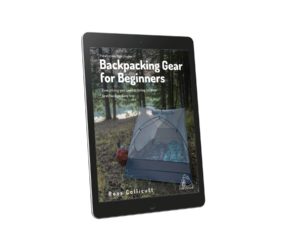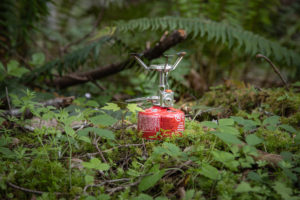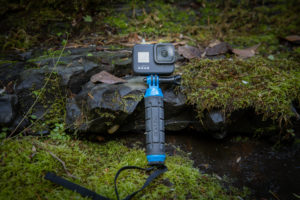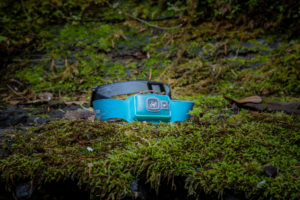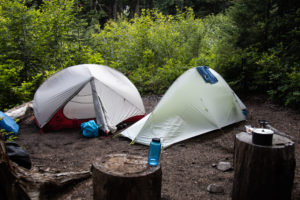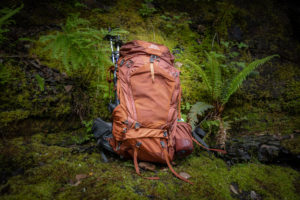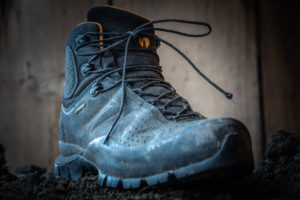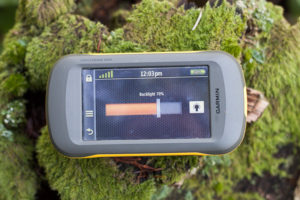If you want a warm meal on your backpacking trip then you’ll need some way to cook it or at least heat up the water.
Some people go stoveless on backpacking trips. All their food is raw, packaged or cold-soaked. It doesn’t reduce your weight not needing a stove. For the rest of us, a hot meal at the end of the day is one of the joys of backpacking.
On this page
- Answer these questions before buying a stove
- What kind of stove should I buy?
- Stove Buying Tips
- Recommended Stoves
- Stove Reviews
- Glossary
- Accessories
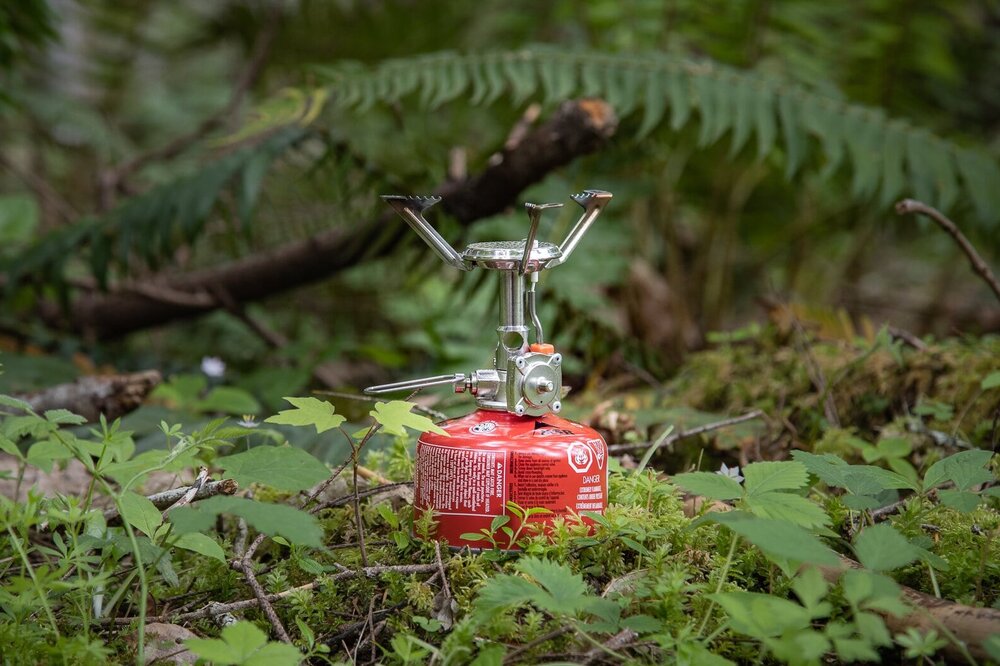
What exactly is a backpacking stove?
There are many different kinds of backpacking stove but they are basically small stoves with small portable fuel canisters. They can be iso-butane gas, liquid white gas, wood or alcohol. Basically anything that burns in a controlled way.
See more about what exactly is a backpacking stove is.
Answer These Before Buying a Stove
Before buying a stove, it’s helpful to know these answers to these questions. There are no wrong answers but they will help you find a stove that works well for you.
- What kind of cooking do you want to do? Are you just boiling water for coffee and dehydrated meals or are you simmering gourmet meals on the trail?
- How much do you care about weight? Does 70 grams (2.6 oz) sound heavy or can a 400 gram (14 oz) stove still be allowed in your pack?
- How many people are you cooking for? Cooking for groups and families is easier with bigger pots and stoves.
- Will you be backpacking in temperatures below freezing? Some stoves don’t well well below freezing.
What kind of stove should I buy?
There are 2 main kinds of stove you’ll see when you first start looking, canister stoves and liquid fuel stoves. We’ll look at each here and a couple other types you may want to consider down the road.
What is a Canister Stove?
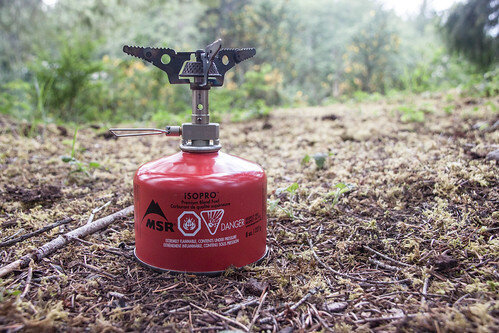
Snowpeak Litemax on an iso-butane canister.
Canister stoves are small stoves that connect to an iso-butane canister (like propane but lighter). They can connect directly to the canister or by a gas tube. This tube lets you put the stove directly on the ground and place the fuel canister away from the flames and food.
Canister stoves are typically small and light. The Snowpeak Litemax (review) weighs 56 grams (2 oz), about the weight of a tennis ball.
These stoves are easy to light as well. Turn it on and light the gas like a BBQ. There’s no priming involved. They’re usually less expensive than liquid fuel stoves as well.
The downside to canister stoves is that it’s hard to tell how much fuel is left in the canister and it’s not recommended to refill them. Canister stoves can be hard to use in temperatures below freezing as the gas becomes a liquid. Some stoves can use this liquid but most cannot.
Some canister stoves have a fuel line from the stove to the canister and are called a “remote” canister stove. Having the stove sit right on the ground means it’s more stable and can have a windscreen around it.
Find out more about canister stoves.
More about Canister Stoves
4 ways to light a canister stove
Why you can’t use a windscreen around a canister stove
Integrated Canister Stoves
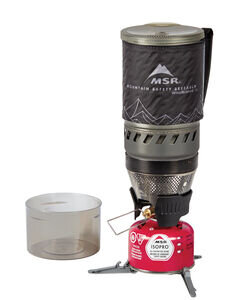
Another category of canister stoves are integrated stoves. These stoves screw onto the top of an iso-butane canister just like a canister stove. The difference is they mount directly to a specialized pot.
Being attached to the stove makes them more stable and very wind resistant. The wind can be blocked on the side of the stove.
Since the wind is blocked and the stove is very close to the pot, these kinds of pots can boil water very fast. They are more difficult for regular cooking and simmering.
What is a Liquid Fuel Stove?
Liquid fuel stoves are larger backpacking and basecamp stoves that use liquid fuel instead of gas canisters.
They tend to use white gas (naptha) but some can also use kerosene or gasoline as well.
The benefits to using liquid fuel are the fuel bottles. You can just pour whatever fuel you like and however much you need into the fuel bottle. For your next trip, just refill. Some of the stoves can use different kinds of fuel like kerosene or gasoline but most can’t.
Liquid fuel works well in the cold below freezing. Cold expeditions always use liquid fuel stoves.
The downsides to liquid fuel stoves is that they’re usually bigger and they take a bit of time to prime and light. It’s a process to prime the stove with a bit of fuel, light it, then slowly release more fuel from the bottle.
More about Liquid Fuel Stoves
Pros and Cons to Liquid Fuel Stoves
Canister and Liquid Fuel Stoves
Some stoves can use both gas and liquid fuel. They do require pulling it apart and changing the jet to make this possible though. The jet is part of the stove that shoots the fuel out to be ignited. This jet is different for the gas and the liquid fuels.
These stoves are good for someone who wants one stove all year. Summer months can just use canisters so it’s easy to use. Winter months and longer trips can use the liquid fuel so you can work in the cold or refill.
More about canister and liquid fuel hybrid stoves.
What is an alcohol stove?
If you venture into the ultralight backpacking word at all, you’ll see some people using what look like a small tin can for a stove. Some of them might actually be cat food can with holes in the side.
Alcohol from drug or hardware stores can be refilled in a small bottle to power these stoves so it’s easy to take just the amount of fuel you need.
The downsides to alcohol stoves is there is no on/off switch. The alcohol you put into the stove needs to burn out. They don’t have the same output as a larger canister or liquid fuel stove and will take a bit longer to boil water.
What is a wood backpacking stove?
If you are in an area that allows burning wood, you might be able to use a small wood-burning stove. They are typically a small cylinder or foldable box made of made. After putting the box together, you can add small pieces of wood and branches and light.
The obvious benefit to wood stoves is not having to bring fuel. You can find wood on the trail. This is also the downside. You’ll need to be allowed to burn wood on your tip. Many sensitive areas and parks do not allow burning wood part or all of the year.
If you are allowed to burn wood, you’ll need to gather it. At the end of a long day it can nice just to press the start button on a canister stove.
Stove Buying Tips
Weight
A stove is yet another thing to put in your backpack so keep in mind it’s weight. Try to go as light as possible while getting the features you need. Don’t forget the fuel. Take as little fuel as possible with a bit extra in case you are out longer than you anticipated.
Burner size
Small stoves will have small burners and larger stoves will have larger burners. Small burners will boil water fine but likely create hotspots on larger pots. If you are looking to use bigger pots or pans look for something with a larger burner. If you are just looking to boil water, any size burner is fine.
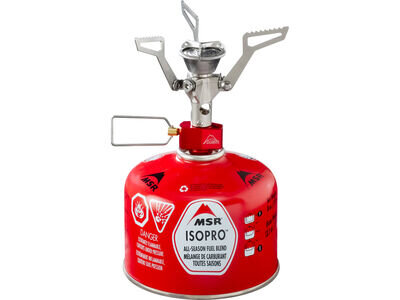
MSR Pocket Rocket 2 Canister Stove
Air Temperature
Canister stoves don’t work well in temperatures below freezing. The gas turns into a liquid below freezing which doesn’t work well with most canister stoves.
Some canister stoves are able to use a ‘drip feed’ mode where you turn the canister upside down and the stove has been built to burn the liquid as well. This lets you use canister stoves in cold weather.
Recommended Stoves
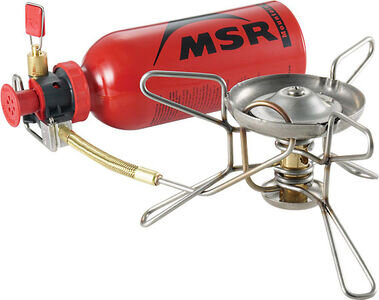
MSR WhisperLite liquid fuel stove
For most new hikers, we recommend small canister stoves start. They are small, lightweight, easy to use and ready available in North America. Stoves like the MSR Pocket Rocket 2 (pictures to the right).
If you are backpacking in sub-zero temperatures, something like the MSR Whisperlite uses liquid fuel and works well in very cold temperatures.
If you need more options for fuel, there are multiple versions to the WhisperLite. The standard WhisperLite burns standard white gas liquid fuel. The International version can burn other liquid fuels like kerosene and gasoline. These are useful in places where you may not be able to buy white gas. The Universal version can also swap parts to connect to canisters for warmer weather.
Stove Reviews
Our thoughts on the latest and greatest camp stoves.
- Jetboil Stash Stove Review: Light and Packable
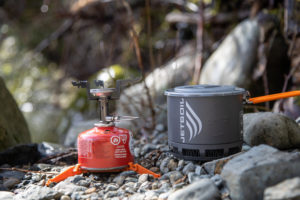
The Jetboil Stash stove is the lightest Jetboil every and boils water quickly but it’s missing a couple things.
- Review: Snowpeak LiteMax Canister Stove
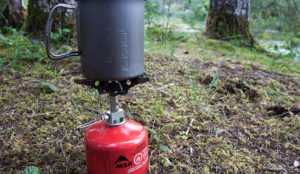 The LiteMax is a small canister stove from Snowpeak, a company that makes lightweight backpacking stoves, cookware and other accessories. The LiteMax is one of… Read More »Review: Snowpeak LiteMax Canister Stove
The LiteMax is a small canister stove from Snowpeak, a company that makes lightweight backpacking stoves, cookware and other accessories. The LiteMax is one of… Read More »Review: Snowpeak LiteMax Canister Stove
Glossary
For a whole glossary on backpacking stove terms, see our Backpacking Stove Glossary.
Accessories
Lighters
You’ll need to light your stove somehow. Some stoves come with a lighter built-in but often they do not. Small lighters like a mini BIC are great for easily lighting stoves. Peizo igniters and flint rods work well too. There are also rechargeable electric fuel free lighters. Always have a backup in case your main lighter gets wet or stops working.
Windscreens
Windscreens just block the wind from hitting the flame on your stove. If the wind is hitting your stove from the side then it’s blowing the heat out the side instead of up onto your pot or may blow the flame out completely. Liquid fuel stoves and remote canister stoves don’t sit right on top of the canister and can have windscreens around them. Windscreens around the stove and fuel can heat it up too much.
Bases
Some companies sell stabilizer legs that attach to fuel canisters to make them more stable. Some of the integrated canister stoves can get very tall and top heavy so it helps to have legs to stabilize the whole thing.
Fuel Canisters
Canister stoves need a canister of iso-butane gas for fuel. These can be found at any outdoor store. Some places more off the grid may not have this kind of gas fuel. If you are travelling, check where you are going has fuel as you can’t fly with these canisters.
Fuel canisters come in different sizes. I like to get the medium size (8oz) and take more than 1 if I need to. They’ll be easier to split up into multiple backpacks and less to carry when they are nearly empty.
Fuel bottles
Liquid fuel stoves will need a bottle for the fuel. There are different sizes available for the length of your trip. Try to get one that will be just big enough for the trips you’ll do.
Other Backpacking Gear
You’ll need more than just a stove to head out backpacking. Here are buying guides to all the other gear you need for backpacking.
- Free Ebook: Backpacking Gear for BeginnersThere’s a lot of stuff you can take backpacking. But not all of it you should. Every wish there was… Read More »Free Ebook: Backpacking Gear for Beginners
- Backpacking StovesIf you want a warm meal on your backpacking trip then you’ll need some way to cook it or at… Read More »Backpacking Stoves
- Cameras for BackpackingThere are 2 camps when it comes to hiking photos: those that never take a picture and just soak it… Read More »Cameras for Backpacking
- Headlamps: How to Buy One for HikingWhen the lights go out in the backcountry, it’s dark. Like really dark. If you want to do anything safely… Read More »Headlamps: How to Buy One for Hiking
- Backpacking Tents: Everything You Need to KnowSmall, light backpacking tents are what most people use for shelter when they’re out backpacking. There are other options like… Read More »Backpacking Tents: Everything You Need to Know
- Backpacking Packs: Everything You Need to KnowSmall backpacks are great for day hikes and travelling but when it comes to staying out in the backcountry for… Read More »Backpacking Packs: Everything You Need to Know
- Hiking Boots
Everything you need to know about hiking boots
- GPS for Hiking
Answers to all your questions about GPS units and phone apps.
Stove Questions?
Still have a burning question about camp stoves and which one you could get? Email us at info@pureoutside.com or leave a comment down below!
